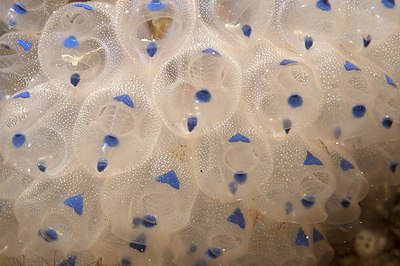
Search
Clavelina australis

Clavelina australis is a species of colonial ascidian from Australia, in the family Clavelinidae.
The species was first described under the name Stereoclavella australis in 1898 by William Abbott Herdman, although that taxon was considered a nomen nudum. A formal taxonomic description of the species was written by Herdman the next year, alongside a tentatively named Stereoclavella sp. ?australis from Broughton Island. The two descriptions differed in the structure of their dorsal languets, united in the latter by a longitudinal band but directly joined to the horizontal membranes in S. australis.
The original genus Stereoclavella was later synonymized with Clavelina, giving the tunicate its currently accepted binomial name.
Like most ascidians, Clavelina australis is a sessile, colonial filter-feeder. Colonies are made of a large number of zooids emerging from a solid stalk-like test. They can average 9 centimetres (3.5 in) in width, while individual zooids are much smaller, around 2 centimetres (0.79 in) in length and 5 millimetres (0.20 in) in width.
C. australis is known from the waters of southeastern Australia. Colonies anchor themselves on rocks and coral reefs in shallow waters, at up to 20 metres (66 ft) of depth.
Inside the genus Clavelina, the closest relative of C. australis has been found to be C. ossipandae, the skeleton panda sea squirt, following the latter's description in 2024.
Text submitted to CC-BY-SA license. Source: Clavelina australis by Wikipedia (Historical)
Owlapps.net - since 2012 - Les chouettes applications du hibou
